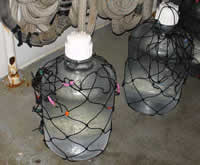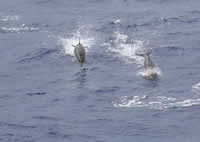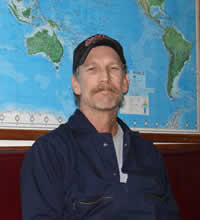


|
The Project Part 3:
Also See: Part 1: Part 2:
|
September 2, 2005
Oh, Boy Carboy This morning the scientists were up early. By 0100 they were capturing their first water samples with the CTD. This time, instead of all the filtering and experimenting, they are placing the water into carboys, which are clear jugs. They are planning on adding 13-C, carbon thirteen, and 15-N, nitrogen fifteen, to the water. They add the extra food, that is slightly different from what the plankton usually gets, so they can see how the plankton functions and at what rate. Then they hook the carboys to a line and placing the whole array back into the water. This creates a protected lab environment right out in the sea. Twenty-four hours later, or 0400 tomorrow, the array will be brought in, and the filtering and experimenting will start once again. The scientists will be able to get a picture of a day in the life of a coccolithophore. This also helps them understand the past when they analyze the sediment on the ocean bottom. When they find the evidence of certain species, they know what they may have looked like in the ocean at that time. While they wait for the carboys, they go back to taking more water samples and analyzing them. The interesting thing about scientists is that they are on a quest to see how things work. They want to understand the world they live in, and then see if there is some affect on the future. We are all scientists in this manner. We want to know how the world around us works. Learning about science also helps us to make better choices for the future. Who would have thought many years ago that studying a microscopic phytoplankton would tell us important information about the ocean's surface temperature, which then could affect the policies we make about global warming tomorrow. Are there areas in your life that you wonder about? Things that you wonder how they work? Be a scientist and observe all you can about your natural world. Perhaps it will influence the decisions of your tomorrow. Last night I was transported to a new level of excitement by one simple word, dolphins. Rick, the Chief Mate, spoke that word to me as I was taking my first bite of pork chop. The dinner was forgotten, the camera acquired, and up the ladder I ran (ships don't have "stairs," they have "ladders"). The crew said the dolphins were most likely feeding on bait fish. As I gazed out at the horizon, all around I saw groups of four or five leaping their way toward the ship. I'm not sure if all these dolphins were one pod, or several pods coming together. They played all around us while we sat stationary in the water. They were gray on top, had a lighter stripe down the side, and a light colored underbody, perhaps tan. Ben, the First Mate, put us in motion, and the dolphins immediately started to play around the boat and in the bow wave. They seemed to know they were the stars of the show, and they performed beautifully. I was giddy and giggling as I snapped picture after picture, and even took a short movie. By the time they left us, my dinner was quite cold, but I didn't mind and ate happily. Today I got a chance to talk to another important part of the ship's crew, the engineers. There are three on board: Hank and Chip are engineers, and Bob is Chief Engineer. We found out early on how important they are when a filtering device broke and Chip had to make it new with what he had available. Engineers basically keep the ship running and mobile. They deal with every engine and piece of machinery on the boat other than the science equipment. They do the plumbing, electrical, welding if needed, and any other thing that comes up. Many have worked their way up to Engineer from their basic Merchant Marine Doc., and some have gone to school to get the needed training. Math Questions:
A sperm whale is 50 feet long and can dive 1.9 miles deep. If you used this ratio, how deep could you dive using your height? Ocean Trivia: The ocean is so blue here. It is very beautiful, clear, and inviting. I know it would not be pleasant to swim in at 50 degrees Fahrenheit, but it still calls to me with it's inviting liquid cobalt/royal blue. So it reminded me of the question so many of us ask as young children: "Why is the ocean blue?" Well, the answer is not as magical as we would like. The ocean looks blue because the sea water absorbs all of the reds, yellows, and greens out of the sunlight. Only the blue light is left to be reflected by the water molecules. If you put particles of some type into the water, it is no longer blue. Which is why sometimes on the coast the water looks green or brown or gray from plants or sediment. The Red Sea is red because it contains seasonal blooms of algae that color the surface water red.
|




